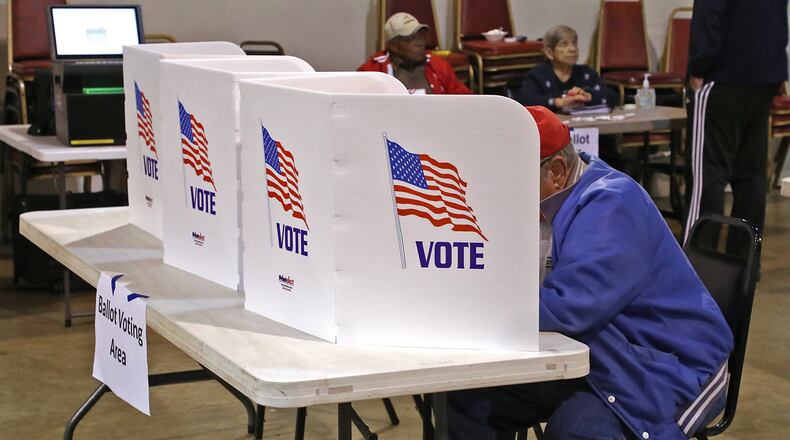RELATED: Superintendent calls Centerville levy “big win”
Statewide, 49 percent of tax-increase school levies were approved Tuesday, according to the Ohio School Boards Association. That’s up from 46 percent passage one year earlier. Renewal levies passed at a 95 percent clip.
West Carrollton schools, which needed several attempts a few years ago to pass a regular operating levy, saw their voters overwhelmingly approve a 37-year bond issue to construct new schools, with funding help from the state.
“It’s amazing. Sixty-three percent (of the vote) is a great number,” said West Carrollton schools business manager Jack Haag. “We had a good feeling coming into it. … Our community has been so supportive.”
But two other levies that passed were the subject of significant debate.
Centerville voters approved a new 6.9-mill levy for daily operations, with 1 mill set aside for building maintenance, by a tight 51-49 ratio. That mirrors the community split the last time Centerville was on the ballot in 2012-13, when residents twice rejected levies by 1 percentage point or less before finally approving an increase.
RELATED: West Carrollton passage means new schools
“All the surveys and research we did really pointed to the fact that the community thinks highly of the school district. But it comes down to money, to are people willing to pay more in taxes?” Superintendent Tom Henderson said. “That’s really the struggle that public school districts face. … The way schools are funded (in Ohio), we have to continue to go back (to the ballot), but we try to delay that as much as possible.”
Some Centerville residents argued the school district did not have to go back to the ballot, suggesting the schools are already of high quality, so managing their existing money would be better than a $12 million annual increase.
The school district’s Facebook page was a mix of celebration and complaint Wednesday, with some anticipating better opportunities for students, while others called the tax increase “very painful on middle-class families.”
In Lebanon, six months after voters rejected a 4.99-mill levy, the result almost exactly flipped, from 56-44 opposed to 56-44 in favor. Superintendent Todd Yohey and other district leaders held a slew of community meetings this fall to connect with voters.
RELATED: Lebanon school levy passes on second try
Yohey said residents who were opposed to the levy believed existing tax rates were too high, or that the school district poorly managed its existing money, or they misunderstood how the levy worked. He said one of the biggest challenges was misinformation, especially in a social media era when an inaccurate claim can spread quickly.
“We had people who thought the school district and city funding were the same pot of money. They said they weren’t going to vote for the levy until we fixed the potholes,” Yohey said. “If somebody knows the facts, the right information, and votes no, that’s OK. Maybe they don’t feel like they can afford it. I just can’t bear the thought of someone voting no because of something they read that just isn’t true.”
Yohey said in the coming months, Lebanon schools will evaluate the teaching positions that were cut after the May levy rejection to see if it will bring some of them back next school year.
Howard Fleeter, school finance consultant to the Ohio Education Policy Institute, said Ohio schools seek local levies more often than in most states because of state law that prevents revenue from those levies from growing along with property values. That leads to “levy fatigue” among voters.
RELATED: Upper Valley Career Center levy explained
But the number of school tax-increase levies on Ohio ballots dropped dramatically from over 130 per year early this decade to just a few dozen per year in 2015-17, according to Fleeter. That number rose last year to 78 levies, and full statewide data for 2019 is not yet available.
This time, local voters approved those levies.
“I think, one, it’s a function of being farther away from the recession and people feel like they’re on firmer ground,” Fleeter said. “And if school districts say it’s been six years since we had a levy instead of three years, I think your chances (of passage) go up.”
November 2015 was the only other election this decade where no school levies were rejected, but that ballot contained only renewal levies, which keep tax rates flat.
Other levies
** Career center: The Upper Valley Career Center's permanent 1.5-mill property tax levy for additional operating money passed with 53.6 percent of the vote in Miami, Shelby, Darke, Auglaize and Logan counties.
Superintendent Nancy Luce said the levy will allow UVCC to expand its welding lab and hire more staff to expand academic programs at its partner high schools, not just at the central campus.
** Renewal levies: Northmont schools voters renewed their existing 9-mill operating levy and made it permanent. Brookville voters renewed two tiny levies for five years, and Miamisburg voters renewed their 8.3-mill substitute levy for five years. New Lebanon voters approved a five-year renewal of their 0.75% income tax levy for schools.
All five Miami County school districts seeking renewals saw them pass — Troy, Tipp City and Miami East with property tax levies, and Bethel and Covington with income tax renewals. Every local renewal passed with at least 60 percent of the vote.
About the Author

